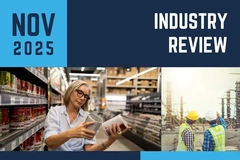
- Industry news
Industry news
- Category news
- Reports
- Key trends
- Multimedia
Multimedia
- Journal
- Events
- Suppliers
Suppliers
- Home
- Industry news
Industry news
- Category news
- Reports
- Key trends
- Multimedia
Multimedia
- Events
- Suppliers
Suppliers
Pharma packaging shift: Balancing global regulations and access as demand for sustainability proliferates

Heightened regulatory scrutiny, patient-centric demands, and global sustainability goals are shifting pharmaceutical and medical packaging design, production, and distribution. Companies cautiously move toward a future where safety and sustainability are not competing but complementary necessities.
The industry is rethinking the fundamentals while navigating an increasingly complex set of expectations. We speak to Coveris, TekniPlex Healthcare, UPM Adhesive Materials, and Alplapharma about the transformation of pharmaceutical packaging.
Melissa Green, head of global marketing at TekniPlex Healthcare, tells Packaging Insights: “Sustainability continues to be a trend across all industries, and healthcare packaging is not immune to it.”
“While drug, device, and patient safety will always come first, the industry is exploring ways to make packaging more sustainable, whether by reducing material use, adopting energy-efficient processes, lowering carbon footprint, or incorporating recyclable, recycled-content, or biodegradable materials where possible.”
Jan-Willem Bruijsten, segment director medical at Coveris, notes: “There’s a shift toward sustainability and not just for cost reasons. Companies are exploring recyclable and monomaterial solutions. The industry recognizes that healthcare packaging must not only protect but also reduce its impact. We’re seeing increased demand for recycle-ready designs, downgauged materials, and overall smarter use of resources.”
Paavo Sillanpää, senior manager for ecosystem pharma and healthcare, EMEIA, at UPM Adhesive Materials suggests that the sustainable trend focus is on the packaging material.
“It is as straightforward as offering a thinner labeling material, but we are also having ongoing discussions to explore whether adding recycled or bio-based content into the label material would be a feasible solution in pharma labeling. However, the pharma packaging qualification process is usually very long, sometimes up to two years, so this is a slower area of transition in comparison to over-the-counter products, or nutraceuticals and supplements,” says Sillanpää.
Evolving global standards
Christian Hehle, global sales director at Alplapharma, points out that the shift away from hard-to-recycle materials and those with a high carbon footprint is driven by regulatory requirements, such as the EU’s Packaging and Packaging Waste Regulation (PPWR).
 TekniPlex offers an evolving portfolio of recyclable blister films and lidding (Image credit: TekniPlex).Hehle says Alplapharma is developing solutions that combine safety, compliance, and sustainability with innovation. It currently focuses on recyclable monomaterial packaging to meet PPWR requirements and enable circularity, advanced barrier technologies, such as multilayer structures with ethylene vinyl alcohol and oxygen/light barriers, to protect sensitive medications.
TekniPlex offers an evolving portfolio of recyclable blister films and lidding (Image credit: TekniPlex).Hehle says Alplapharma is developing solutions that combine safety, compliance, and sustainability with innovation. It currently focuses on recyclable monomaterial packaging to meet PPWR requirements and enable circularity, advanced barrier technologies, such as multilayer structures with ethylene vinyl alcohol and oxygen/light barriers, to protect sensitive medications.
Alplapharma is looking into the integration of regulatory-compliant recycled content in pharma packaging. The company also aims to integrate fiber-based materials, as well as smart packaging and traceability features, including QR-codes and anti-counterfeiting technologies like SafePha, to ensure product authenticity and patient safety.
Meanwhile, Green indicates that as globalization increases medical and healthcare access worldwide, it is key for packaging products to meet different regulations and maintain international quality standards.
“TekniPlex’s facility in Suzhou, China, represents a strategic approach to serving Asia-Pacific markets through scalable customization capabilities. While manufacturing locally, our China operations leverage TekniPlex’s global technology network. This ensures consistent quality and performance standards regardless of production location, addressing multinational customers’ need for supply chain reliability.”
“Regulatory scrutiny of medical device materials continues to intensify, driven by dual imperatives: ensuring patient safety and minimizing environmental impact.”
Green notes that authorities such as the US Food and Drug Administration, the European Medicines Agency, and EU regulators are requiring stricter standards.
In terms of chemical safety, testing extractables and leachables, including heavy metals, persistent organic pollutants, and phthalates, has become more stringent, she says.
Regulations for biocompatibility dictate that materials must not trigger adverse biological responses when in contact with the body over the prescribed period of use, according to Green.
At the same time, there is a growing emphasis on recyclability, reduced carbon footprint, and sustainable feedstocks that is shaping material selection.
“Our strategy is clear: anticipate regulatory change, exceed current requirements, and equip our customers with materials that ensure compliance, safety, sustainability, and functionality, today and in the future.”
Patient-centric and clinician-friendly
 Alplapharma focuses on plastic packaging for the pharmaceutical sector, with various standard products, specialization and innovation (Image credit: Alplapharma).The healthcare and pharmacy sector is becoming more human-centered, and companies are aiming to support patients and caregivers through improved packaging design, according to Sillanpää at UPM Adhesive Materials.
Alplapharma focuses on plastic packaging for the pharmaceutical sector, with various standard products, specialization and innovation (Image credit: Alplapharma).The healthcare and pharmacy sector is becoming more human-centered, and companies are aiming to support patients and caregivers through improved packaging design, according to Sillanpää at UPM Adhesive Materials.
“The increasing prevalence of chronic conditions such as diabetes means that injectables are now the fastest growing packaging segment. Alongside this, there has been a rise in self-medication, due to the ever-increasing cost of healthcare, therefore, the need for injection pens, pre-filled syringes, and on-body injectors and monitoring is increasing.”
“Add to this the popularity of weight loss drugs, and it is no surprise that demand for delivery systems such as pre-filled syringes, ampoules, vials, cartridges, and injection pens is on a growth curve. In addition, COVID-19 led to a significant rise in the use of vaccines that need to be stored at minus 80 degrees Celsius, and this has meant increasing demand for labels that can accommodate extreme conditions,” he explains.
“With consumers having a continued focus on managing their own health, an emerging area is wearable devices. Although we are not talking about traditional label materials, the assembly and attachment of these devices to the patient requires specialized self-adhesive materials. So, the wearables trend is opening up interesting opportunities for further innovation in this area.”
Green echoes that the rise of patient-centric solutions is a key trend. “Packaging is designed to support adherence, education, and trust. This includes formats that help patients take medications on time and as prescribed, provide critical product information, and ensure the medication is authentic, stable, and uncompromised. In some cases, this may also extend to the integration of smart technologies.”
“Ease of use is another increasingly important differentiator,” she says. For packaging used in professional healthcare settings, “intuitive, efficient designs can improve the clinician’s experience and influence product preference in MedTech and pharma.”
Developing next-gen materials
Coveris’ Bruijsten shares that there can be challenges in moving away from traditional materials or designs, especially when it comes to “products that are bulky or have sharp edges.”
.jpg) Coveris’ solutions are available in monomaterial constructions, enabling recyclability while meeting sterility and barrier standards (Image credit: Coveris).“These often require additional material strength. In such cases, we sometimes need a slightly thicker monomaterial than what would be used in a traditional multi-layer solution. That can lead to a minor increase in pack weight. But the key advantage remains: it’s a single polymer, making recycling and waste separation far easier. And that’s a trade-off many partners are willing to make,” he says.
Coveris’ solutions are available in monomaterial constructions, enabling recyclability while meeting sterility and barrier standards (Image credit: Coveris).“These often require additional material strength. In such cases, we sometimes need a slightly thicker monomaterial than what would be used in a traditional multi-layer solution. That can lead to a minor increase in pack weight. But the key advantage remains: it’s a single polymer, making recycling and waste separation far easier. And that’s a trade-off many partners are willing to make,” he says.
“We’re focused on developing high-barrier monomaterials, solutions that could one day replace aluminium-foil laminates. These materials must maintain all the critical performance features while offering a more sustainable end-of-life. It’s ambitious, but it reflects our belief that sustainable innovation must be just as trustworthy and reliable as conventional solutions, and eventually, even more so.”
Hehle from Alplapharma says: “Our strategy is building long-term, innovation-driven partnerships with proven expertise and capabilities, supporting our customers as a quality collaborator throughout the entire product lifecycle.”
According to TekniPlex’s Green, material science drives TekniPlex’s work. “We’re developing materials-based solutions that help companies meet the evolving trends of our industries.”
“All of our recyclable materials are designed to be processed where suitable recycling infrastructure exists. For healthcare packaging applications, we are exploring the use of reduced-carbon substrates for laminated structures that can offer a variety of environmental and sterile barrier properties. TekniPlex has also developed a line of recyclable polyester-based films for rigid medical device packaging.”
Sillanpää adds that UPM offers a range of materials with PCR content, bio-based renewable feedstocks, and label solutions made from waste streams like used cooking oil.
“Adoption of these materials has already seen progress in FMCG applications, and we are evaluating how these solutions could be implemented in pharma packaging. We have dedicated solutions for applications where potential migration is of concern, such as eye droppers and blow-fill-and-seal packaging.”
UPM supports pharma companies in their Extractables and Leachables studies by providing a comprehensive support package on its low migration adhesives.
“Ultimately, product and patient safety are always the number one priority in the pharmaceutical and healthcare industry.”
However, Sillanpää says the industry is moving forward as consumers are pushing for more sustainable packaging. “With this in mind, our products are assisting the switch to more sustainable solutions and allowing them to choose options that support packaging recyclability and reuse.”











